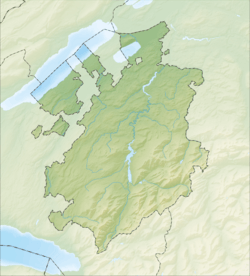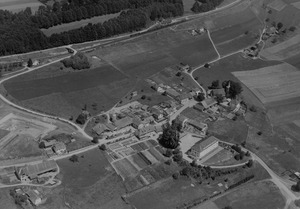Matran facts for kids
Quick facts for kids
Matran
|
||
|---|---|---|
|
||
| Country | Switzerland | |
| Canton | Fribourg | |
| District | Sarine | |
| Area | ||
| • Total | 2.91 km2 (1.12 sq mi) | |
| Elevation | 614 m (2,014 ft) | |
| Population
(Dec 2020 )
|
||
| • Total | 1,620 | |
| • Density | 556.7/km2 (1,442/sq mi) | |
| Postal code |
1753
|
|
| Surrounded by | Avry, Corminboeuf, Hauterive, Neyruz, Villars-sur-Glâne | |
Matran is a small town, also called a municipality, in the canton of Fribourg in Switzerland. It is located in the Sarine district.
Contents
Matran's Story: A Look at Its History
Matran was first mentioned way back in 1123. Over time, its name changed a few times, from Martrans to Matrans, and finally to Matran. The name comes from "Martyrus."
From Hamlet to Modern Town
In the Middle Ages, a powerful church called the Abbey of Payerne owned a lot of land in Matran. Later, in 1442, the small village was sold and became part of Fribourg. After a big change in government in 1798, Matran joined the county of Fribourg. In 1848, it became part of the Sarine District.
Matran has grown a lot! It used to be a quiet village with only a few hundred farmers. But in the last 25 years, its population has grown to over 1,000 people.
Important Buildings and Art in Matran
Matran has a beautiful Gothic church that was built in the 1500s. Inside, you can see rare paintings from the 1700s on the ceiling. These paintings show the four evangelists, but we don't know who the artist was. There's also a huge bronze sculpture called a Pieta by an artist named Hugo de Matran at the town's mortuary.
The town is also known for the former Kollegium Sankt Joseph. This used to be a boarding school run by the Redemptorist Fathers. Since the early 1990s, it has been used as a spiritual retreat center for groups. The chapel there is often used for TV broadcasts.
Famous People from Matran
Many interesting people have been part of Matran's history. Some former students and teachers from the Kollegium Sankt Joseph include:
- Peter Fahr, a Swiss author.
- Francois Seydoux, an organist and music professor.
- Luc Seydoux, another organist.
- Father Alois Schmid, an author and biology professor.
- James d'Argantel Odrowaz, a painter and author.
Matran is also the home of the talented sculptor and painter Hugo de Matran, whose real name is Hugo Heule.
Matran's Landscape: Exploring Its Geography
Matran covers an area of about 2.9 square kilometers (about 1.1 square miles). Let's look at how this land is used:
- Farmland: About 51.4% of Matran's land is used for farming. This includes fields for growing crops and pastures where animals graze.
- Forests: Around 19.2% of the area is covered by thick forests.
- Buildings and Roads: About 29.7% of the land is used for buildings, roads, and other developed areas. This includes homes, businesses, and transportation routes.
- Rivers and Lakes: A small part, about 0.7%, is made up of rivers or lakes. All the water in Matran is flowing water, like streams.
Where is Matran Located?
Matran is in the Sarine district. It sits on the left side of the Glane river. The town is about 614 meters (2,014 feet) above sea level. It's also quite close to Fribourg, the capital of the canton, about 5.5 kilometers (3.4 miles) away.
Matran's Symbol: The Coat of Arms
A coat of arms is like a special symbol or emblem for a town or family. Matran's coat of arms has a blue background. On it, there is a golden lion standing up. This lion has a red tongue and holds a red cornucopia, which is a horn-shaped basket. The cornucopia is filled with red roses that have green leaves.
Who Lives in Matran? Demographics
Matran has a population of about 1,600 people. In recent years, the population has grown quite a bit, by about 26.4% over ten years. Most of this growth is because people have moved to Matran.
Languages Spoken
Most people in Matran speak French as their first language, about 87.5%. The second most common language is German, spoken by about 7.5% of the population. A smaller number of people, about 1.4%, speak Italian.
Age Groups in Matran
The population of Matran is made up of different age groups:
- Children and Teenagers: About 31.5% of the population are young people aged 0 to 19 years old.
- Adults: About 59.6% are adults aged 20 to 64 years old.
- Seniors: About 8.9% are seniors, who are over 64 years old.
Population Growth Over Time
The chart below shows how Matran's population has changed throughout history:

Matran's Work Life: The Economy
In Matran, the unemployment rate was about 3.9% in 2010. Many people work in different types of jobs.
Types of Jobs in Matran
Jobs are often grouped into three main types:
- Primary Sector: This includes jobs related to getting raw materials, like farming. In Matran, about 11 people work in this sector.
- Secondary Sector: These jobs involve making things, like in factories or construction. About 480 people work in this sector in Matran.
- Tertiary Sector: These are service jobs, like working in shops, offices, or schools. About 530 people work in this sector.
Many people who live in Matran also travel to other towns for work. About 10.8% of workers use public transportation, and most, about 76.9%, use a private car to get to their jobs.
Faith in Matran: Religion
In Matran, most people are Roman Catholic, making up about 80.7% of the population. Another group, about 6.7%, belongs to the Swiss Reformed Church. There are also smaller numbers of people who are Orthodox Christian, Christian Catholic, or other Christian faiths. About 1.19% of the population is Islamic. Some people also identify as Buddhist, or have no religious affiliation.
Learning in Matran: Education
Education is important in Matran. About 31.1% of the people have finished high school, and 16.2% have gone on to higher education, like university or a specialized college.
The School System in Fribourg
The Canton of Fribourg has a specific school system:
- Kindergarten: Children start with one year of optional kindergarten.
- Primary School: This is followed by six years of primary school.
- Lower Secondary School: After primary school, students go to three years of lower secondary school. Here, students are grouped based on their abilities.
- Upper Secondary School: After lower secondary, students can choose to go to an optional three or four-year upper secondary school. This can be a gymnasium (which prepares students for university) or a vocational program (which teaches job skills).
- Higher Education: After upper secondary, students can go to a university or continue with an apprenticeship.
In the 2010–11 school year, Matran had 157 students in 9 classes. Many students from Matran also attend schools in nearby towns, especially for secondary and higher education.
Getting Around: Transportation
Matran has its own railway station, called Matran. This station is on the Lausanne–Bern line. You can catch regular trains from Matran to Romont FR and Fribourg/Freiburg. This makes it easy for people to travel to and from the town.
See also
 In Spanish: Matran para niños
In Spanish: Matran para niños





